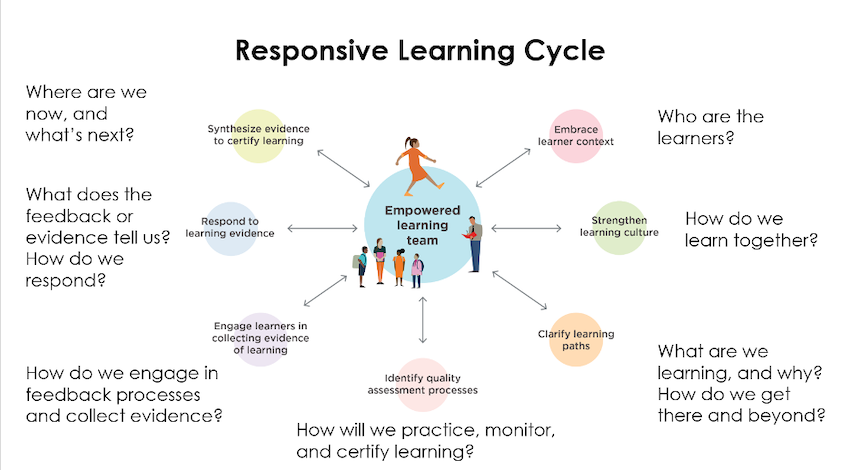
Teachers have assessment literacy questions for their own professional development, but teachers also need to know: how do I bring my students along on the assessment journey? When it comes to empowered learners, an essential piece of the puzzle is ensuring they not only understand but also own their assessment experience. When it comes to student assessment literacy, how do we get our students on board and bought in?
To better understand this, I sat down with Aly Martinez Wilkinson, a professional learning lead here at NWEA. Her rich classroom experience in curriculum and instruction informs her passion for equitable, engaged classrooms. Together, we tackled three essential questions to help you increase student assessment literacy.
Question #1: What does it mean to be assessment literate, in the words of a fifth-grader?
Let’s start by defining the word “assessment.” “To assess” simply means to evaluate and gather information. An assessment is any assignment—an exit ticket, homework, a quiz, a test, a computer assessment, like MAP® Growth™—that’s being evaluated to determine where a student is in their learning. Assessments can be formal or informal; they can be diagnostic (“Where do we start?”), formative (“How’s it going?”), or summative (“How did it go?”). They can even be public, like when a teacher supervises a group project.
Invite your students to popcorn any activities or assignments that could qualify as an assessment. From there, engage in a discussion about the purposes of different assessments. What does an exit ticket show, as opposed to take-home homework? Why have a presentation assessment in the same class as an essay? This helps students understand the purpose of each assessment, and it establishes a classroom norm of ongoing assessment awareness. This classroom culture will help achieve what Aly labels as essential: “It’s important that students truly feel that we aren’t doing this ‘to’ them, but for and alongside them.”
To be clear, assessment literacy is not quite the same as data literacy. Assessment literacy encompasses the entire process: intention of the assessment, creation of the assessment, and retrospection (evaluation of efficacy and results) of the assessment. Data literacy focuses on understanding the results generated from an assessment, including spotting trends and applying data to instructional decisions. Data literacy certainly improves assessment literacy, but do not fear: students don’t need to be in AP statistics to have a meaningful relationship with assessment. In fact, assessment literacy encourages everyone to be more mindful of the journey and less focused on the results.
Teacher tip: Sometimes it’s hard to fully categorize an assessment as solely diagnostic or purely summative. Don’t worry! A balanced assessment system puts the focus on formative assessment, as most learning is perpetually ongoing.
Question #2: How do we empower students to become assessment literate?
When it comes to empowering learners, Aly frequently cites the responsive learning cycle: the intentional dismantling of the traditional “sit-and-get,” “sage-on-the-stage” teaching paradigm. Moving learners away from being passive recipients to empowered learners involves a decentering of the teacher and a recentering of students as managers of their knowledge journey.

What’s important to accept about implementing a responsive learning cycle mindset is that it is not an easy shift for almost any party involved. Teachers will have to constantly revisit old methodologies and curricula, asking who they serve and whether the learning is relevant, responsive, and meaningfully measurable. These questions are hard, and teachers don’t always have the full tanks of gas required to answer them. Meanwhile, students may not immediately enjoy this repositioning of themselves at the center because guess what? It requires more of them! Being aware of these primary roadblocks—teacher burnout and student apathy—and frontloading how valid these responses are will give everyone a longer fuse during the process.
It’s all about small steps toward a larger culture shift. Teachers, try these tips with your students to gently move the needle toward a more responsive learning cycle:
- Ask students to help create assessments in class. Students can write questions and suggest projects that will demonstrate their learning. If you’re just starting out or have younger learners, start small by having students submit test review questions and evaluate them as a class. “Is this a strong question that invites students to demonstrate their learning? How could we make it better?”
- Constantly reframe students as the teacher. Invite them to brainstorm what true student understanding could look like with questions such as, “If you were teaching this concept, what’s the most important thing you’d want your students to understand? What would you need to see demonstrated from a student?” Conversely, ask them what could get in the way of or falsify student learning: “What’s a question or assignment that a student could complete without really understanding this at all? As a strong teacher, what would you worry students could hide that they don’t really ‘get’?”
- Help students link assessment design integrity with assessment result integrity. In order to create a culture of (respectful) data review, try this: Share imaginary test results where every student got an A. Ask students what they would assume about that assessment. They might say things like, “It wasn’t very hard” or “Everyone must have studied!” Ask them, “Was this a good assessment?” Students may offer that if everyone got an A, it might not have been very challenging. As the conversations get richer, introduce different fake data sets, spanning all levels of possible student performance. Ask students new questions: “Is a strong assessment ‘challenging’? Is a ‘B’ a bad grade? Why would a teacher worry if everyone ‘bombed’ a test? Imagine a really good test. What do you predict the range of scores to be?” You might be surprised at how intuitive students already are about assessments. They’ll likely be surprised, too!
- Print and highlight assessment statements. Whether you’re a school leader, teacher, student, or family member of a K–12 student, the following assessment literacy assets from the Nebraska Department of Education can help capture and calibrate the journey: school leader assessment literacy statements, “Teacher foundational statements,” and “Student and family foundational statements.” Consider highlighting a handful of statements that you already feel a tight grasp on. In another color, highlight a few statements to focus on. Revisit these statements after an assessment and have a professional development or classroom huddle to share how it’s going.
Question #3: How do we encourage student assessment literacy when many teachers get hives about their own assessment literacy?
This is such a valid question! Teachers, we understand the need to feel supported in your assessment journey. Let’s be clear: assessment literacy is the start-to-finish, intention-to-results journey of mindfully evaluating student learning. You are already more assessment literate than you think!
Aly constantly reassures educators, saying that when it comes to assessment literacy, it’s normal to feel a bit panicked. But the good news is, being assessment literate does not mean you’re a data scientist. It means that you’re on an ongoing (unfinished!) journey toward holistically viewing what we teach students and how we measure the learning. That’s it.
Great teachers want to empower learners, and the power of student advocacy when they are invested in their own learning pays dividends in the classroom. Aly points out the connection between student assessment literacy and the responsive learning cycle: “When our students feel like they have some say in how they demonstrate what they’re learning, the temperature in the classroom changes—for the better.”
And leaders, any less-than-glowing reactions teachers have to assessments and assessment literacy are often rooted in real emotions of feeling unsupported or uninformed. Our resource on answering teacher questions about assessment might be useful! It’s essential to meet teachers’ needs regarding assessment literacy so that teachers can meaningfully model this mindset for students.







